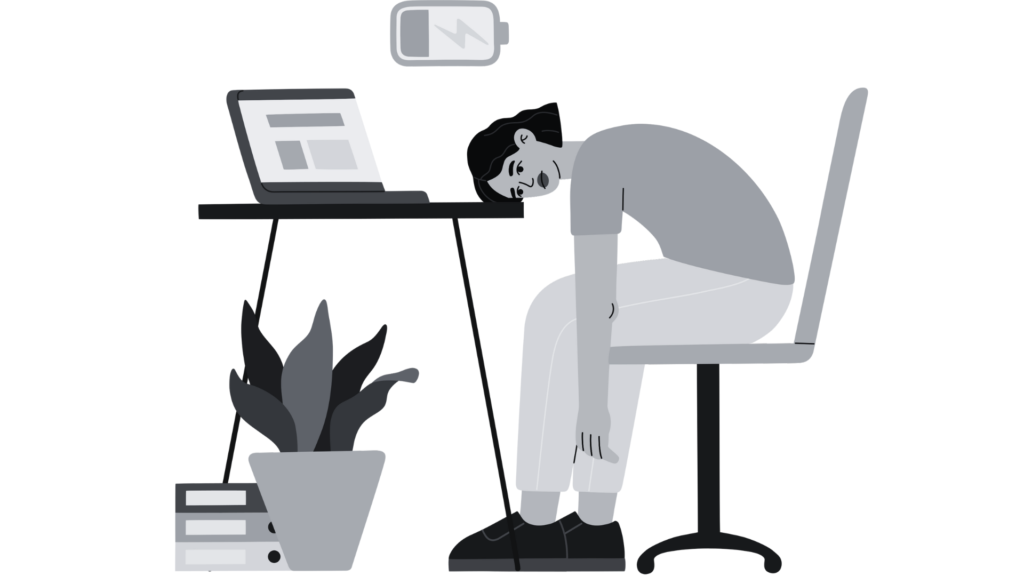You’ve probably heard the term burnout tossed around in chats or whispered across coffee breaks. But what if we told you there’s a roadmap to it?
That’s right—the 12 stages of burnout can help you identify, understand, and avoid the full-on crash many in the tech industry silently suffer from.
If you’re in tech—whether you’re debugging lines of code at midnight, launching another sprint, or just trying to keep up with ticket overload—this guide is for you.
Recognizing burnout early is crucial for preventing it from getting worse and ensuring timely interventions.
Let’s break it down, talk human-to-human, and explore how burnout happens, why it’s so common in our industry, and what to do if you see yourself (or your team) on this slippery slope.

What Is Work Burnout?
Burnout refers specifically to a state of complete mental, emotional, and physical exhaustion caused by prolonged stress, particularly chronic workplace stress that an individual hasn’t successfully managed. Energy depletion is a critical aspect of burnout, alongside increased mental distance from one’s job and reduced professional efficacy.
It’s not just “feeling tired” or “having a bad week.”
It’s when your brain, body, and heart all say, “We’re done.” You may experience physical symptoms such as headaches, insomnia, or stomach problems.
You may feel a lack of motivation, inner emptiness, or even detached from your personal life and values.
In severe cases, burnout:
- Causes mental health challenges
- Impacts interpersonal relationships
- Derails your physical and mental well-being
Causes of Burnout
Burnout often stems from chronic workplace stress that you haven’t learned to manage yet.
The workplace stressors usually involve:
- An excessive workload
- Poor work-life balance
- Insufficient social support
- Lack of control over your tasks
Personality traits like perfectionism and low self-esteem can also increase your risk.
When you neglect your own needs and prioritize work over your personal life, it leads to physical and mental fatigue, making it even harder to manage stress levels.
Understanding these causes is essential for developing effective strategies to prevent and recover from burnout. By addressing these root issues, you can create a healthier, more balanced approach to work and life.
Why Burnout Is So Common in Tech
Let’s be real—tech isn’t a 9-to-5 job. The pace is fast, deadlines are tight, and “just one more deploy” can turn into another late night. Many of us take pride in being problem-solvers.
But the darker side? That tendency to prove oneself often leads to ignoring our own needs, denying rest, and brushing off the burnout symptoms.
Add too many tasks, unclear work boundaries, and a culture that glorifies “the grind,” and you’ve got a perfect storm. It’s no wonder that many individuals feel overwhelmed by the demands, leading to exhaustion and a decline in well-being. And that storm often hits people who are already dealing with chronic stress, mental fatigue, and intense workplace stress.
Why Understanding the Stages Matters
Burnout doesn’t just appear overnight. It’s a gradual process.
That’s why spotting the stages of burnout is so powerful—it allows you to manage stress, identify early signs, and shift direction before you do more damage.
The initial stage is where individuals feel compelled to establish their worth and capabilities, often leading to over-commitment and unrealistic goal setting as they strive to impress others and validate their competencies.
Understanding these stages can:
- Improve your self-awareness
- Help you recognize emerging problems
- Allow for earlier stress relief interventions
- Encourage you to prioritize self-care
- Guide teams toward a healthier work-life balance
The 12 Stages of Burnout (And What They Feel Like)
Burnout expert Herbert Freudenberger first identified these 12 stages to describe the slippery slope from enthusiasm to collapse. You might not go through every stage in order, but knowing what to look for is the key.
Job burnout is increasingly prevalent in workplace settings, making awareness and strategies to mitigate its effects crucial for employees’ well-being and organizational safety.

1. The Need to Prove Oneself
It starts with ambition. You want to impress, go the extra mile, and show your worth.
This desire to prove your abilities isn’t bad, but if unchecked, it can become obsessive and dangerous.
Consulting a mental health professional can help identify the root causes of burnout and provide the necessary professional help to navigate stress and develop effective coping strategies.
2. Exhaustion Stage
You take on too many tasks and push limits. Skip breaks, cut off time for personal needs, and say yes when you should say no.
3. Neglecting Personal Needs
Sleep? Optional. Eating? When you remember.
You start sacrificing your physical well-being, hobbies, and personal relationships for work.
Neglecting other life aspects, such as personal interests and social interactions, contributes to burnout and stress, which is why setting clear boundaries is vital.
4. Displacement of Conflict
You minimize problems and become irritable. Maybe coworkers seem “annoying” now. Maybe everything outside of work feels like a distraction.
5. Revision of Values
Work replaces your identity. You feel disconnected from your personal values and the aspects of life that once mattered—friends, family, fun.
6. Denial of Emerging Problems
You’re not the problem—everyone else is. Odd behavioral changes show up. You get cynical, blame others, and stop being emotionally available.
7. Withdrawal
You isolate yourself. You stop reaching out. Emotional support from others feels unwanted or even annoying.
8. Obvious Behavioral Changes
This stage is noticeable. You’re more impatient, angry, or numb. People around you notice the shift, even if you don’t.
9. Depersonalization
You start seeing others as objects or problems, not people. You feel detached from interpersonal relationships and the meaning of your work.
10. Inner Emptiness
There’s a heavy sense of mental exhaustion and emotional emptiness. Some try unhealthy coping mechanisms like binge-watching, overeating, or drinking.
11. Depression
You feel hopeless. Burnout, chronic fatigue kicks in. Your mental health, emotional well-being, and physical health all take hits.
12. Burnout Syndrome (Collapse)
This final stage is where physical and mental fatigue become disabling.
You may need time off, professional help, or even hospitalization due to severe burnout.
Overcoming burnout requires self-care, therapy, and building a strong social network to navigate stress and regain emotional balance.
Real-World Examples in Tech Roles
Let’s say you’re a systems admin pulling night shifts. At first, you’re excited and energetic.
But over time, you start skipping meals to finish work, ignoring your body, and losing sleep.
A developer might go from eager to detached, then numb, only to suddenly snap at coworkers or stop caring about code quality entirely.
Or take a support engineer fielding back-to-back tickets—they could go from responsive and cheerful to ghosting Slack, experiencing emotional and physical exhaustion, and avoiding team huddles. They may feel disconnected from their own emotions and thoughts, which can lead to negative self-perceptions.
Burnout doesn’t always scream. Sometimes, it whispers.
Yellow Tail Tech’s Programs: Built for Skill-Building Without the Burnout
At Yellow Tail Tech, we don’t believe in grinding you into the ground to get you career-ready.
We designed our programs to support your long-term growth while protecting your work-life balance.
Instead of piling on endless assignments or overwhelming you with self-paced chaos, we offer structured, instructor-led training with clear milestones, built-in support, and real accountability—without the stress overload.
We focus on providing an environment where you can master in-demand tech skills at a realistic, sustainable pace.
We train you for success in tech and ensure you have everything you need to succeed without sacrificing your health. Because in this industry, your skills matter—but so does your well-being.
Check out our Lnx for Jobs program, a specialized, career-driven track that trains you to become a Linux System Administrator, even if you’re starting from scratch.
How to Use This Knowledge (Without Overhauling Your Whole Life)
Knowing the 12 stages of burnout doesn’t mean you have to quit your job tomorrow or book a wellness retreat in Bali. But here’s how you can use this information to overcome burnout, reclaim your mental well-being, and take back your personal life:
Maintaining a strong personal connection with your work and colleagues is crucial to prevent emotional exhaustion and depersonalization, which are key components of burnout.
1. Track Your Energy Levels
Start journaling how you feel at the start and end of the day. Energy dips can help you pinpoint stress levels or early signs of burnout.
2. Reclaim Your Personal Identity
Remember that you’re more than your job title. Explore what brings you joy outside of work.
3. Reset with Self-Care
It’s not selfish. Rest, movement, and a balanced diet help restore physical health and emotional balance. Severe burnout can lead to serious health consequences, including various physical ailments that may require medical attention.
4. Set Boundaries at Work
Learn to say no. Block off lunch hours. Silence work notifications after hours.
5. Talk to Mental Health Professionals
There’s zero shame in getting help. Seek professional support if you’re deep in mental fatigue or facing severe anxiety. Prolonged stress and exhaustion can lead to physical collapse, necessitating immediate intervention to restore well-being.
6. Normalize Breaks and Flexibility
Need a mental health day? Take it.
Feeling overloaded? Speak up.
The best teams allow for human needs. You can also talk about it with your career coach.
An expert can offer advice, listen to you, and help lighten your burden.
7. Create a Culture of Emotional Health
If you’re in leadership, make emotional support and mental health part of team culture.
This culture would involve:
- Modeling balance
- Real connection
- Vulnerability
Burnout can strain both personal and professional relationships, affecting interactions and connections in both spheres.
How Long Does It Take to Recover from Burnout?
Burnout recovery isn’t a one-size-fits-all process. For some, it can take a few months.
For others, especially when an individual has ignored or pushed through for too long, it may take a year or more to happen.
How quickly you recover from burnout depends on:
- When you recognize the signs of burnout
- The amount of rest and realignment you allow yourself
- Whether you’re addressing the deeper causes rather than just treating symptoms.
- Recovery usually requires a combination of professional support, lifestyle changes, healthier boundaries, and time to rebuild emotional and physical resilience.
Healing from burnout isn’t about bouncing back overnight—it’s about gradually restoring your energy, your motivation, and your sense of self at a pace that’s sustainable and real.
Maintaining Mental Health
Maintaining mental health is crucial for preventing burnout and promoting overall well-being.
This mental maintenance involves prioritizing self-care, seeking support from mental health professionals, and developing effective stress management techniques.
Regular exercise, mindfulness practices, and a balanced diet can help reduce stress levels and promote emotional well-being.
By taking proactive steps to maintain your mental health, you can reduce your risk of burnout and enhance your overall health and well-being. Remember, taking care of your mental health is not just about avoiding burnout; it’s about thriving in all aspects of your life.
A Final Word on Burnout Recovery
Burnout recovery isn’t linear. You might bounce between stages.
But even recognizing you’re on the path to recovery is a powerful start.
Remember: You are not alone. You’re not weak. You’re not “failing.”
Burnout is a response to overwhelming stress, not a personality flaw.
With a bit of self-awareness, honest reflection, and support, you can regain your emotional well-being, rebuild physical and mental health, and return to work and life with strength.
Untreated burnout can contribute to various severe conditions such as depression, anxiety, and heart disease.
If you’re working in tech and feeling like burnout is creeping up on you, you’re not imagining it.
The signs are real; the impacts can be detrimental, but the tools for change?
They’re within reach.
Prioritize self-care, talk to your team, or seek support from mental health professionals. Your work matters—but so do you.
At Yellow Tail Tech, we care about your growth and your health. Whether you’re just starting in IT or eyeing a career switch, we help people build skills without burning out.
If you’re ready for a tech journey that supports your goals and your well-being, book a 10-minute intro call today. We’re here to help you rise, not crash.
Frequently Asked Questions
- Why is burnout so common in the tech industry?
Burnout is common in tech because the industry is fast-paced, deadline-driven, and often glorifies overwork. Long hours, high pressure, and a “grind culture” can push professionals to ignore their personal needs until they reach mental and physical exhaustion. - How long does it take to recover from burnout?
Recovery from burnout varies. Some people feel better after a few months of rest and lifestyle changes, while others may take a year or more. The timeline depends on how early you spot the signs, whether you address root causes, and if you get professional support. - What is the difference between stress and burnout?
Stress is usually short-term and tied to specific situations, while burnout is long-term, ongoing exhaustion that affects your physical health, mental clarity, and emotional well-being. Stress may motivate you temporarily, but burnout leaves you feeling depleted and detached. - Can burnout affect my physical health?
Yes, burnout can cause headaches, insomnia, stomach issues, and even increase the risk of heart disease and depression. Prolonged burnout impacts both mental and physical health, which is why early recognition and recovery are so important.






